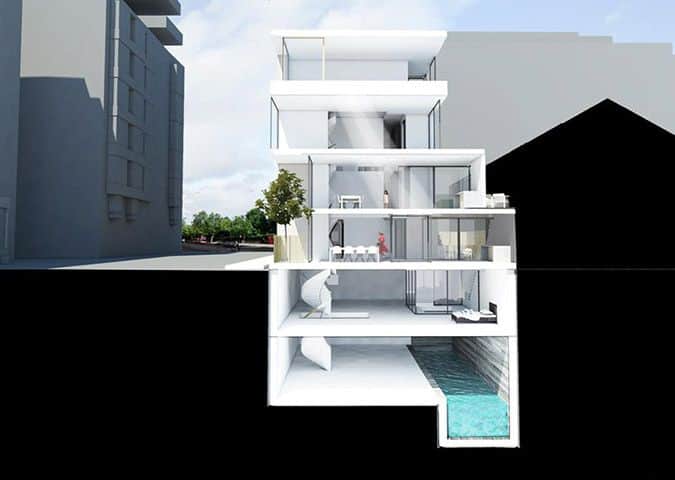BLOG
INTERESTING STUFF
THAT CAUGHT OUR EYE
Basements: Myths Versus Facts

Lady Carr-Ellison is one of our most distinguished clients. A few years ago, we completed a substantial kitchen renovation and extension to her beautiful Victorian house in London.
Despite being overjoyed with our work, I’ve yet to convince her that we can build just as well underground as we can above ground.
We asked her to tell us about her concerns so that Rob Graham, managing director of Cube Construction, can reassure her that basement developments can be safe, secure and comfortable.
Lady Carr-Ellison’s Concerns:
Structural Damage
By far my biggest concern would be damaging the structure of my house. No amount of extra space is worth the risk of threatening my beloved home. Removing such a large quantity of soil and changing the foundations of the structure can’t be good for the stability of a house.
It would be even worse in a terrace. Luckily, my house is detached, but if I did have adjoining walls I can just imagine cracks tearing through my walls caused by a neighbour excavating beside my property – not to mention the months of noise and inconvenience.
Water
Whenever I talk to my friends about basement developments, the main question is always, where does all the water go? Not only will you be displacing the groundwater – especially dangerous in flood risk areas – but if you’ve got plumbing in the basement then you need to find a way of getting rid of all of your waste water.
I hardly see the point in spending money on a basement if it’s going to be riddled with damp problems and plagued with the ghastly racket of a water pump every time I use the plumbing.
Comfort
If I was to go ahead with the considerable expenses and risks to extend my property, I would want the space I gain to be as comfortable and attractive as possible. I’ve yet to be convinced that such quality of space is possible in a basement.
Being underground limits access to natural light and ventilation, and I simply can’t imagine ever being happy in a dark, stuffy box. Though John assures me there have been tremendous advancements, I’ve yet to see a basement development that I would consider to be worth the costs.
Rob Graham’s Response:
Structural Damage
A safe build is all about process. Before any work is done on the property, a complete temporary works should be in place which combines the structural engineer’s designs, the ground surveys and a permanent works scheme. Simply put, a poorly planned build shouldn’t ever start in the first place.
Once work starts, regular monitoring by an independent structural engineer (ideally not in-house with the contractor) will make sure that the contractor is following the temporary works scheme and alert to any changes.
Oversights during the temporary works is where things go wrong with basement developments, and by “wrong” I mean a door getting jammed. For the vast majority of cases that’s the extent of the problem, severe structural damage is a very, very rare exception.
Remember that domestic basements pale in comparison to the complexity and impact of large scale subterranean construction such as tube lines and shopping centres. If they can be completed successfully, digging beneath a house shouldn’t be an issue.
Water
Solving the issue of water has two phases: the first is keeping the water our during construction, which can be achieved with a de-watering system.
The second is to keep water out of the finished basement. A dry basement is achieved by identifying areas of seepage in the concrete then drilling, plugging and sealing them before any further work starts.
After the concrete shell is in place it’s wrapped in a membrane that transfers groundwater to the pump, which is also equipped with a 24 hour backup battery and the option of a telemetric system that automatically calls for help should the pump fail when you’re away.
There’s also no reason to worry about the noise of the pump. Pumps do generate some noise but, like a boiler, it shouldn’t be placed anywhere it would be audible. If a pump is unpleasantly loud, then it’s either faulty or poorly positioned.
Comfort
Let’s start with air quality, as that’s more my area. Fresh air used to be a problem in basements but has since been solved by heat recovery systems. These pump warm, stale air out and use the energy to warm up fresh air coming in, keeping the structure well ventilated while regulating its ambient temperature.
Light can enter a basement through front and rear lightwells if they’re available but without smart architectural and interior design this light will go to waste.
Reflective surfaces, large spaces and bright materials help light spread around the basement, making it feel more open and airy. That’s where John and the team at DGA come in. I’ve worked with them on many breathtaking basements that feel just as comfortable as the floors above them.
Back to John
A big thank you to Lady Carr-Ellison and Rob Graham for letting our readers see both sides of what can be a very unbalanced debate. If you have any questions or concerns of your own, call us on 020 8108 3612.
